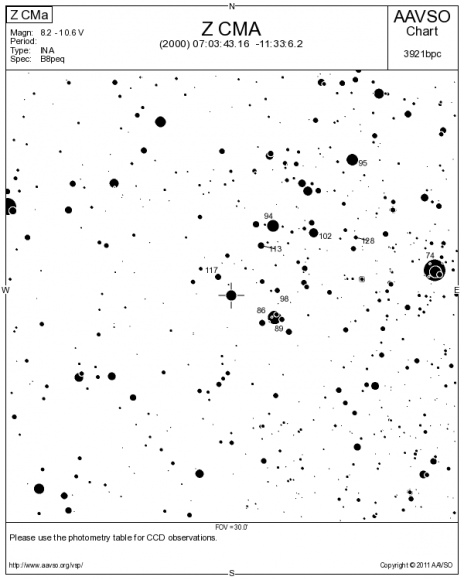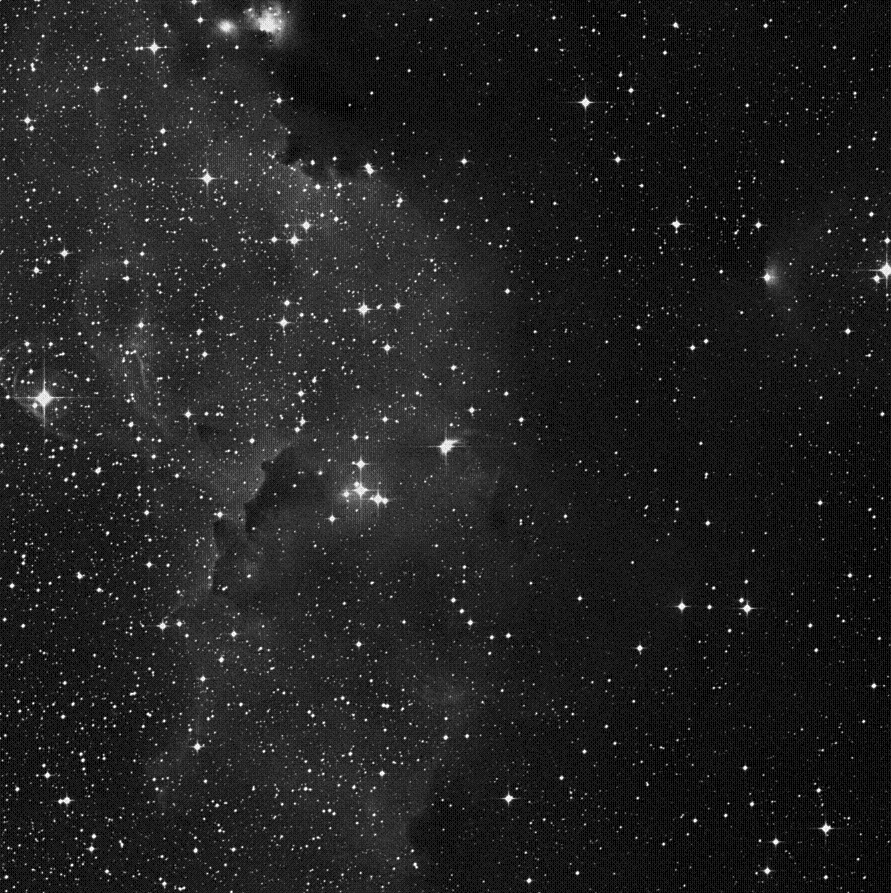[/caption]
Heads up, weekend warriors! With very little Moon to contend with, it would be a great time to observe the bright outburst of the pre-main sequence variable star, Z Canis Major. It has gained more than two magnitudes and is well within binocular and small telescope range.
From the AAVSO Special Notice compiled by Elizabeth O. Waagen: “John Bortle, Stormville, NY, reports that the pre-main sequence binary variable Z CMa is in outburst, according to his observation of 2011 February 4.0 UT at visual magnitude 8.5. Observations in the AAVSO International Database confirm this outburst, which may have begun as long ago as April 2010, when it began brightening slightly from visual magnitude 10.7. When Z CMa emerged from its seasonal gap in November 2010, it was already 9th magnitude.

The current outburst is as bright as the one that occurred in 2008, the brightest in the star’s known history. Z CMa is a very interesting object, a binary composed of a Herbig Be star and an FU Ori star. The Herbig star is embedded in nebulosity. The system is an x-ray source and has an x-ray jet. According to Stelzer et al. (2009, Astronomy & Astrophysics v.499, p.529, and astro-ph arXiv:0903.4060), the FU Ori star is the source of both the optical outbursts and the x-ray emission. Observations of Z CMa (RA 07:03:43.16 Dec -11:33:06.2) are strongly encouraged, both during the current outburst and throughout the observing season. With its range of visual magnitude ~8.0 – 10.5, it is an excellent visual observing target.”
Our thanks to John Bortle and the American Association of Variable Star Observers (AAVSO) for drawing our attention to the current outburst of this interesting system!


Ahem…. R.A. 06h20m18.8s, Dec. ?30°03?48?
This star is also known as Furud or Phurud.
I wish you guys would make a habit of publishing the co-ordinates when discussing observable objects…
SIMBAD (J2000) and NED only varies slightly from AAVSO’s coordinates for Z Canis Majoris:
RA: 07 03 43.24
Dec: -11 33 13.3
Check your info again, sweetie!
Firstly, openly patronising responders here just isn’t good form.
If you are really going to mention observable objects in articles, you should give the name of the variable (or object), at least some kind of alternative designation I.e. HIP 34042, HD 53179, etc, give some form of co-ordinates straight up, and if possible where is roughly located in the sky. At least avoids some of the general confusion inherent with stellar nomenclature.
The central issue is that no everyone is up to speed with the various designations used for stellar objects. Variable star specialists often use odd-syntax for stars and variables alike, and unless you know the sometimes awkward syntax, it remains very confusing even among experienced amateur observers.
If you must present articles like these, it might be best to have a little insert box with the details. This is similar to the wiki boxes used in Wikipedia used for celestial objects. In this case;
Z CMa / HIP 34042 / HD 53179
R.A. : 07h 03m 43.3s
Dec. : +11° 33′ 06″
Spectral Class : Bpc
Magnitude : Variable Star c. 8.0V to 10.5V
Type : FU Ori
Oh, and you should have probably mentioned that telescopically the star appears as orange-red in colour, most probably caused by light absorption for the surrounding nebulosity.
Hmm… i lguess I shouldn’t use Wikipedia?
http://en.wikipedia.org/wiki/Zeta_Canis_Majoris
I wonder how many other co-ordinates listed by Wiki are wacky?
Wikipedia position for Zeta CMa is correct
I.e. 06h 20m 18.8s -30° 03′ 48.1″
Wikipedia’s position for Z CMa is correct;
I.e. 07h 03m 43.3s ?11° 33′ 06.2″
What the heck are you talking about here??
AH HAAAA! I got my Zeta and my Z CMa’s confused… Oops… Thanks for the correction HSBC.
aqua? you’re just havin’ a bad night, dude….
“Observations of Z CMa (RA 07:03:43.16 Dec -11:33:06.2) are strongly encouraged, both during the current outburst and throughout the observing season.”
recalculating…. turn right now! 😀
SURPRISE! Clear skies! Last night I was out with my 4.5″ reflector until 1am. Due to viewing limitations here in the canyon. I did not get to see Z CMa…rats…. instead thru the holes in the trees, I saw M42, M43, M1, M35 & NCG2158, M36, M37, M38, M44, M45, M48, M65 and M66! I looked for but did not see the Horsehead Neb. as I was too lazy to go inside, make a bunch of noise and find my filters? I did not see any aurora activity here at 38degN in Calif.
Z CMa is not the same as Zeta (ζ) CMa (Canis Majoris), which is 3rd magnitude star. (I can understand the mixup, as Greek capital for zeta is ‘Z’.)
The nebulosity in the picture is IC 2177
* Zeta CMa is known very wide double star, SMY1
Can anybody draw a dog on both pics? Is it Furud or not? How are retards like me supposed to know where it is?
It’s confusing. The AAVSO chart has west on the left side while in the Palomar picture west is to the right.
Z CMa is the star in the middle of the chart, marked with crosshairs.
Go to http://www.aavso.org/vsp, enter Z CMa as name and set ‘WOULD YOU LIKE TO DISPLAY A DSS IMAGE ON THE CHART?’ to ‘Yes’.
I’ll get the same chart like here, but I still can’t draw the dog. 😀
I hope this works: http://www.nightskyatlas.com/viewer.jsp?rightAscension=7.0&b01=1&b07=1&declination=-11.5&b02=1&viewAngle=90.0&b03=1&b09=1&viewRotation=0.0&b04=1&b10=1&width=700&b05=1&b11=1&height=500&b06=1&b12=1&b00=1 (the image may take some time to load).
You can also search for ‘HIP 34042’ in Stellarium (http://www.stellarium.org/).
Other free planetarium software: http://www.astrosurf.com/c2a/english/index.htm , http://www.ap-i.net/skychart/start
It is not Furad, as that is Zeta CMa~